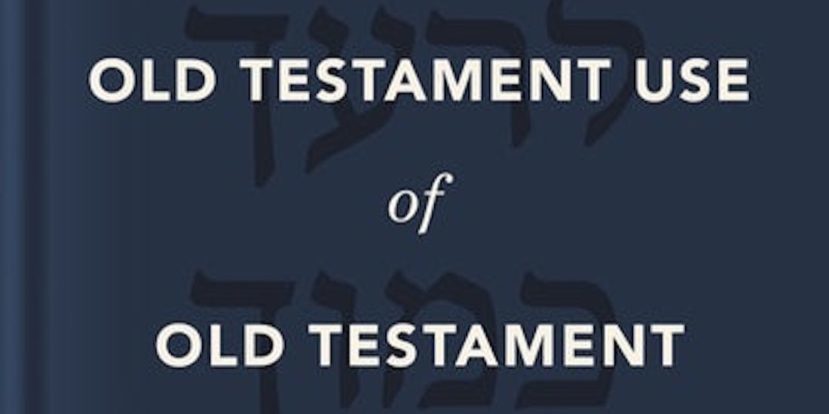
Surprises of Old Testament Use of Old Testament: Part 2
There are many books on the New Testament use of the Old Testament. But most of the time the rest of how the Bible uses the Bible gets ignored. Unfortunately, failure to take adequate account of the use of scripture within the Old Testament leads to faulty New Testament exegesis and diminishes the contribution of scripture to theology.
I spent the past few years researching and writing a reference work on the use of scripture within Israel’s scriptures entitled Old Testament Use of Old Testament.[i] The long research for this project led to some things I did not expect. It is not a book of hermeneutical theories. It is not based on a few examples. This project includes cataloging and evaluating hundreds of cases of biblical interpretation within the Bible, and it explains the hermeneutical profile of the use of scripture within every book of the Old Testament. Although I have worked on the Bible’s use of the Bible for decades, several parts of the research surprised me.
Unexpected Observation Two:
Use of Torah within Torah
Biblical scholars have a growing awareness of challenges in the ways the New Testament uses scripture. But progressive revelation does not start there. And thinking that it does is part of the problem.
Old Testament prophets never seem to tire of looking back as the basis for looking forward. They look ahead to a new creation, a new Israel, a new exodus, a new temple, and even a new covenant. In the Old Testament, expectations for what Yahweh shall do are grounded on what Yahweh has done. That is who he is.
Prophets, psalmists, storytellers, sages, poets, and visionaries of Israel’s scriptures had been using the Torah and earlier prophets and psalms long before the days of the earliest Christians. The evidence suggests that later Old Testament authors closely studied earlier scriptures. Commitment to the word of God by the biblical authors makes it natural for them to recycle, reinterpret, and redeploy scriptural revelation.
Put differently, there is nothing at all unusual about the ways the authors of the New Testament use scripture.[ii] They followed a well-worn path of biblical exegesis that they found within their Bible. But there is more.
If the New Testament authors interpret their Bible the way the prophets and psalmists interpret scripture, it is natural to wonder if that is where it started. Studying the Old Testament use of scripture shows that the prophets and psalmists did not invent their brand of biblical interpretation. It starts with Torah. Even though I had seen the hints, I was still surprised.
The authors of Israel’s scriptures interpret Torah in line with the ways the later parts of Torah interpret the earlier parts. Torah itself provides an authoritative guide for later scriptural authors to advance revelation by exegesis of scripture.
The Spirit of God used the word of God as one tool for advancing revelation. Perhaps the close study of Torah and the early prophets by later scriptural writers falls within what could be called “canonical consciousness.” Devotion to Yahweh and close study of his word by scriptural writers helps explain the deep continuity that runs through the Old Testament and into the New Testament. Devotion to Yahweh and close study of his word by scriptural writers helps explain the deep continuity that runs through the Old Testament and into the New Testament. Click To Tweet
Exegetical Advancements
Yahweh adjusts and re-adjusts his own legal standards for his people. The very idea of adjustments to divinely given laws needs to give pause. The five special narratives of legal precedent and legal amendment by Yahweh himself underscore the importance of exegetical advancements of revelation within Torah. At least as long ago as Philo (c. 20 BCE–c. 50 CE), five legal precedent and amendment stories became a place to start to think about the significance of revelation of the divine will.[iii] Among these, for example, at the first Passover celebration in the wilderness, Yahweh makes a legal amendment for persons in a state of ritual impurity or traveling to celebrate Passover one month later.[iv] Yahweh also goes so far as to adjust his own adjustments when he makes a new ruling for females to inherit land and then amends his legal adjustment to prevent tribal lands from being diminished by females inheriting and marrying outside the tribe.[v] These legal amendments start when his people appeal to Yahweh.[vi] Yahweh’s own exegetical advancements in the form of legal amendments demonstrate that law serves the redemptive relationship not the other way around.
There is no such thing as a book of Torah that lacks exegetical advancements of Yahweh’s will. In the aftermath of the debacle with the golden calf Yahweh upgrades some of his own laws. As a symbol of forgiveness and renewal Yahweh issues the covenant renewal collection of laws in Exodus 34:11–26. The collection of renewal laws includes a series of exegetical enhancements of the earlier covenant collection of laws in Exodus 21–23. The importance of these divinely ordained exegetical advancements of revelation within the book of Exodus relates to how law serves redemption. Exodus presents the first laws to Israel and also many exegetical upgrades to these laws by Yahweh himself.
An attitude of “this is the law, do not ask questions” has nothing to do with the redemptive revelation of Yahweh’s will. Leviticus and Numbers house numerous exegetical advancements of divinely revealed law. Some of the adjustments come when things change and others when people appeal to Yahweh.[vii] Deuteronomy as a whole is referred to as “Torah explained.”[viii] From beginning to end Deuteronomy houses exegetical advancements of revelation to prepare Israel to enter the land of promise.
That divine revelation endures does not mean the revealed will of Yahweh stands on display in Torah like fossils in a museum exhibit. The dynamic, redemption-driven exegetical advancements of divine revelation in Torah naturally set the course for the way revelation unfolds in the Old Testament prophets, historical narratives, and psalms. The entire set of scriptural interpretations in the Old Testament leads to the kind of biblical exegesis on display in the New Testament. When it comes to exegetical advances of scripture, what goes before remains living and active precisely because of what comes after.
In sum, the exegetical enhancements and advancements of scriptural prophets, psalmists, and historical narrators carry forward the exegetical practices found in Torah. All of this bears on the New Testament’s revelation of the gospel of Messiah according to the scriptures.
What culminates in the gospel begins in Torah.
**See part one of Schnittjer’s series of Surprises of Old Testament Use of Old Testament.
Footnotes
[i] See Gary Edward Schnittjer, Old Testament Use of Old Testament (Grand Rapids: Zondervan Academic, at press).
[ii] See ibid., chap. on Toward the New Testament.
[iii] See Philo, Life of Moses II, ed. and trans. F. H. Colson, Loeb Classic Library 289 (Cambridge, MA: Harvard University Press, 1935), §§192–245. The five narratives appear in Lev 24:10–23 (execution of the blasphemer); Num 9:6–14 (amendments to Passover regulations); 15:32–36 (execution of the sabbath-breaker); 27:1–11 (allowance for female inheritance); 36:1–12 (adjustments to female inheritance).
[iv] Num 9:6–14.
[v] Num 27:1–11; 36:1–12.
[vi] Num 9:7; 27:1–4; 36:2–4.
[vii] For example, when the tabernacle moves Yahweh’s holiness into the center of the camp, it triggers new measures for handling individual ritual impurity (Num 5:1–4).
[viii] Deut 1:5.

